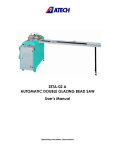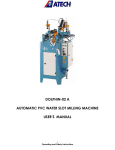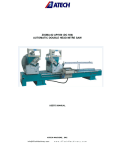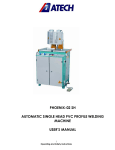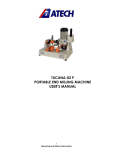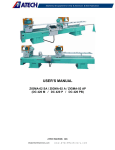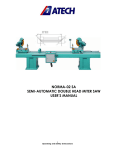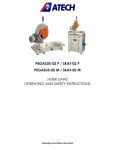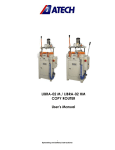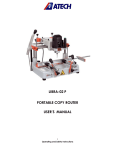Download SKAT-02 M MANUAL MITER SAW User`s Manual
Transcript
SKAT-02 M MANUAL MITER SAW User's Manual 1 Operating and Safety Instructions CONTENTS Page 1. General Information 1.1. Introduction 1.2. Distributor 2. Machine’s Description and Purpose of Use 2.1. Machine’s description 2.2. Technical features 2.3. Cutting diagram 2.4. Overall dimensions 2.5. Part lists and technical drawings 3. Safety 3.1. Safety information 3.2. Accident prevention 3.3. General safety information 4. Electric Connection 5. Transport of the machine 6. Operation 6.1. Adjusting the air pressure of pneumatic clamps 6.2. Angle cutting on the machine table 7. Safe installation of the saw blade 8. Maintenance 8.1. Routine controls and maintenance 8.2. Maintenance at the end of the working day 9. Troubleshooting Guide 10. Wiring Schemes 10.1. Single-phase wiring scheme 10.2. Three-phase wiring scheme 2 Operating and Safety Instructions 3 3 3 3 3 4 4 5 5 7 7 7 8 9 10 11 11 13 14 15 15 15 16 17 17 18 1. GENERAL INFORMATION 1.1. INTRODUCTION The user’s manual given by the manufacturer contains necessary information about the machine parts. Each machine operator should read these instructions carefully, and the machine should be operated after fully understanding them. Safe and efficient use of the machine for long term depends on understanding and following the instructions contained in this manual. The technical drawings and details contained in this manual constitute a guide for the operator. 1.2. DISTRIBUTOR ATech Machine, Inc. 10752-A Tucker Street – Beltsville, MD 20705 USA Phone: +1-301-595-1816 Fax: +1-301-560-6627 Website: www.ATechMachinery.com E-mail: [email protected] In case of any technical problem please contact your nearest ATECH dealer, or ATECH head office through the above mentioned phone, fax or e-mail address. Technical labels with the model description of the machine are fixed onto the front side of each machine. The machine’s serial number and manufacturing year are stipulated on the technical label. 2. MACHINE’S DESCRIPTION AND PURPOSE OF USE 2.1. MACHINE’S DESCRIPTION Manual miter saw for serial cutting of PVC (vinyl), aluminum and wooden profiles in desired angles. Cutting at locked angles of 150-22.50-300-450-900, and at intermediate angles via fixing screw. Machine has been designed according to UL & CSA Safety Directives. The clamping is pneumatic, cutting is manual. Please include the below mentioned data in all your correspondence regarding the machine with the manufacturer and/or your ATECH dealer. *Machine model *Machine’s serial number *Voltage and frequency *Name of dealer where machine was purchased *Date of purchase *Description of the machine fault 3 Operating and Safety Instructions *Average daily operation period 2.2. TECHNICAL FEATURES Technical Features SKAT-02 M 3 HP (2.2 kW) d=30-32 mm (1.2”/1.3”) 1-Phase 220V 60Hz D=400 mm (16”) 3000 rpm 90-120 psi 2.3. CUTTING DIAGRAM 4 Operating and Safety Instructions 0.2 CFM 75x60x134 115 kg (30”x24”x53”) (253 lbs) 2.4. OVERALL DIMENSIONS 2.5. PARTS LIST AND TECHNICAL DRAWINGS No. 1 2 3 4 5 14 Description Washer Ring Saw blade outer ring M10 reverse teeth tightening bolt Special ring Saw blade 5 Operating and Safety Instructions Qty 1 1 1 1 1 1 3. SAFETY 3.1. SAFETY INFORMATION The symbols shown hereunder are necessary to be read with special attention. Not reading or observing of them may cause damage to the equipment or personal injury. IMPORTANT The IMPORTANT symbol above is one telling to apply special care and to be careful at carrying out the specified operation. CAUTION ! The CAUTION! Symbol above warns you against specific dangers, and requires to read the text. Not observing may cause damage to the equipment. DANGER WARNING The above symbol DANGER WARNING, warns you against specific dangers, and you have definitely to read them. Negligence may cause damage to the equipment and bodily injury. Read the user’s manual carefully before using the machine or carrying out maintenance works. 3.2. ACCIDENT PREVENTION 3.2.1. Our machines are manufactured in accordance with EN 60204-1 and EN 292-2 CE safety directives, which cover national and international safety directives. 3.2.2. It is the task of the employer to warn his staff against accident risks, to train them on prevention of accidents, to provide for necessary safety equipment and devices for the operator’s safety. 3.2.3. Before starting to work with the machine, the operator should check the features of the machine, learn all details of the machine's operation. 3.2.4. Machine should be operated only by staff members, who have read and understood the contents of this manual. 6 Operating and Safety Instructions 3.2.5. All directives, recommendations and general safety rules contained in this manual have to be observed fully. The machine cannot be operated in any way for purposes other than those described herein. Otherwise, the manufacturer shall not be deemed responsible for any damages or injuries. And such circumstances would lead to the termination of the warranty. 3.3. GENERAL SAFETY INFORMATION 3.3.1. The power cable should be led in such a way that nobody can step on it or nothing can be placed on it. Special care has to be taken regarding the inlet and outlet sockets. 3.3.2. If the power cable should be damaged during operation, don't touch and unplug it. Never use damaged power cables. 3.3.3. Don’t overload machines for drilling and cutting. Your machine will operate more safely with power supply in accordance with the stipulated values. 3.3.4. Don’t place your hands between parts in motion. 3.3.5. Use protective eye glasses and ear plugs. Don't wear oversize clothes and jewels. These can be caught by moving parts. 3.3.6. Keep your working place always clean, dry and tidy for accident prevention and safe operation. 3.3.7. Use correct illumination for the safety of the operator. (ISO 8995-89 The Lighting of Indoor Work Systems) 3.3.8. Don't leave anything on the machine. 3.3.9. Don’t use any materials other than those recommended by the manufacturer for cutting operations on the machine. 7 Operating and Safety Instructions 3.3.10. Ensure that the work piece is clamped appropriately by the machine's clamp or vice. 3.3.11. Ensure safe working position, always keep your balance. 3.3.12. Keep your machine always clean for safe operation. Follow the instructions at maintenance and replacement of accessories. Check the plug and cable regularly. If damaged, let it replace by a qualified electrician. Keep handles and grips free of any oil and grease. 3.3.13. Unplug first, before conducting and maintenance works. 3.3.14. Ensure that any keys or adjustment tools have been removed before operating the machine. 3.3.15. If you are required to operate the machine outside, use only appropriate extension cables. 3.3.16. Repairs should be carried out by qualified technicians only. Otherwise, accidents may occur. 3.3.17. Before starting a new operation, check the appropriate function of protective devices and tools, ensure that they work properly. All conditions have to be fulfilled in order to ensure proper operation of your machine. Damaged protective parts and equipment have to be replaced or repaired properly (by the manufacturer or dealer). 3.3.18. Don’t use machines with improper functioning buttons and switches. 3.3.19. Don’t keep flammable, combustive liquids and materials next to the machine and electric connections. 4. ELECTRIC CONNECTION 4.1. The machine is supplied with 1-Phase or 3-Phase 220V 60Hz motor. Please check label. The power cable socket has to be in accordance with the socket on the machine. 4.2. Use a connection cable socket in accordance with the UL Safety Directives. 4.3. Check the inlet power supply before powering the machine. CAUTION ! * The socket connections have to be made by a qualified electrician, the rotation direction of the saw blade has to be observed by starting the machine. If the saw blade 8 Operating and Safety Instructions rotates in reverse direction, the socket connections have to be checked and reconnected properly. **If the saw blade rotates in reverse direction, it will cause danger for the operator and the equipment. To correct the rotation direction of the saw blade, insert the electric power socket of the machine to the 3-phase slot, which has been prepared before, and follow these instructions: 1. Press the Motor Start Button to operate the saw blade. 2. Press the two green buttons on the control panel simultaneously, which will cause the cutting head to lower and the guard to open. 3. Release the green buttons. Observe the rotation direction of the saw blade through the open part of the blade guard. 4. The correct direction of the saw blade rotation is shown above. If the saw blade rotates in reverse direction: The electric socket connections have to be checked and corrected by a qualified electrician. The rotation direction of the saw blade should not be defined before testing. 5. TRANSPORT OF THE MACHINE IMPORTANT The transport should be done by qualified personnel only. The machine should be transported by lifting with proper equipment (not touching the ground during the transport). 9 Operating and Safety Instructions Don’t lift the machine before ensuring that lifting devices or other equipment is placed properly under the machine. 6. OPERATION The manual miter saw Skat-06 M cuts non-ferrous aluminum, PVC profiles and wood. Inner and outer sharp edges of the carbide tipped circular saw blade ensures high quality clean cutting results. The cutting length can be precisely read and adjusted using the measuring tape fixed to the back fence. CAUTION ! Start the machine only after proper clamping of the work piece to be cut. The machine is equipped with horizontal clamps. The clamping positions, either manual or pneumatic clamps, can be adjusted comfortably according to the material. The clamping cylinders have to be outside of the saw blade moving area. (See Illustrations below) IMPORTANT The air pressure of the machine has to balance 6-8 Bar (90-120 psi) air pressure. Don’t operate the machine with an air pressure lower than 6 Bar (90 psi). 6.1. ADJUSTING THE AIR PRESSURE OF PNEUMATIC CLAMPS 6.1.1. Pull the adjustment button of the conditioner upwards. a- Turning the adjustment button in clockwise direction increases the pressure b- Turning the adjustment button in counter clockwise direction decreases the pressure c- Once you read 6-8 Bar on the manometer, push the adjustment button of the conditioner down and lock it in that position. 10 Operating and Safety Instructions Pressure Adjustment Button Manometer Oil Depot Air Pressure and Water Discharge Screw Oil Filling Tap 6.1.1. Place the material to be cut on the machine table, take the measure the cutting length using the measuring tape on the back fence, and clamp the work piece (pneumatically). 6.1.2. Start to operate the saw blade by pressing the Start button. 6.1.3. Carry out the cutting operation by pressing down the two green buttons on the control panel simultaneously. 6.1.4. After cutting off the material, release the buttons and the head moves back to its original position, press the Stop button. The saw blade will come to a full stop within 15 secs. 6.1.5. Release the clamps (pneumatically) and take out the cut work piece. 6.1.6. The conditioner unit collects the water within the air system in a receptacle in order to prevent damage to the pneumatic system components. Discharge this water periodically (at the end of the working day) by pressing or opening the button under the conditioner. 6.1.7. The manufacturer recommends to use the following oils with the conditioner: TELLLUS C 10 / BP ENERGOL HLP 10/ MOBIL DTE LIGHT . Don’t operate the saw while it touches the work piece. The saw must be operated only when the head is in the top position. 11 Operating and Safety Instructions 6.2. ANGLE CUTTING ON THE MACHINE TABLE Don’t operate the machine while the material to be cut is on the machine table. Machine has always to be operated when the saw head is in the upper position, and lowered after the saw blade has reached its normal speed. 6.2.1 Press the saw blade down until it is inserted into its slot on the machine table. 6.2.2. Pull the snap pin from its lock so that the machine table is released. 6.2.3. Adjust the desired cutting angle by turning the saw head to the left or right respectively. 6.2.4. Following angles are locked via the snap pin: 15°-22.5°-30°-45°. DETAIL A: Intermediate angle setting screw DETAIL B: Angle display scale The table can be fixed at any desired intermediate angle using the scew. At intermediate angles the snap pin is not in locked position. The machine table is tightened only temporarily. CAUTION! Ensure that the clamp is always outside of the cutting area. CORRECT WRONG 12 Operating and Safety Instructions 7. SAFE INSTALLATION OF THE SAW BLADE 7.1 To remove the circular saw blade from the blade shaft, follow the instructions below (see also illustration above). 7.1.1. Remove the M8 screw by turning it counter clockwise with a 8 mm hexagonal key. (Hold the saw blade shaft at the opposite end with a 17 mm wrench key and prevent so that the shaft turns. 7.1.2. Remove the washer and the outer nut washer. 7.1.3. Take out the saw blade carefully. 7.1.4. Insert the new saw blade on the saw blade shaft, ensuring correct rotation direction. 7.1.5. Insert the other parts (washer, outer nut washer) in reverse order as removal. 7.1.6. Tighten the M8 screw while holding the blade shaft with a 17 mm wrench key in fix position. 7.1.7 It is necessary to sharpen / replace the saw blade in certain intervals depending on the cutting material. If the cut material leaves burr after the cutting operation or if the saw blade is strained, it needs to be sharpened / replaced. CAUTION ! 7.1.8 When replacing the saw blade, use a saw blade washer which is in accordance with the saw blade shaft diameter. The outer diameter of the blade washer is 30 and 32 mm. 13 Operating and Safety Instructions 8. MAINTENANCE 8.1. ROUTINE CONTROLS and MAINTENANCE 8.1.1 STARTING TO WORK 8.1.1. Ensure that the table and all kind of parts are clean and dry. Degrease and dry the table. Especially ensure that the holding grips are clean and dry. 8.1.2. Remove all burr, chip and foreign materials from all surfaces of the machine. Use protective eye glasses. 8.1.3. Check the saw blade before each use. Turn the saw blade carefully (after removing the blade guard) to see the teeth of the saw blade. Replace the saw blade if it is damaged. 8.1.4. Check the pressure of the air pressure system. If necessary, adjust the air pressure between 6-8 Bar (90-120 psi). 8.1.5. Check the air pressure filters and the oil level of the conditioner. Fill up if the oil level is low. Unplug and disconnect the air pressure connections first, before carrying out these works. 8.2. MAINTENANCE AT THE END OF THE WORKING DAY 8.2.1. Disconnect electric and pneumatic connections. (Main Switch must be on “0” position) 8.2.2. Remove all burr, chip and foreign materials from the machine surfaces. If it is necessary to clean the inside of the blade guard, remove the front cover, use gloves to protect your hands from the sharp edges of the blade. 8.2.3. If water or water based liquids were used during cutting, dry the machine with a dry cloth after the operation is finished. 8.2.4. Apply a thin layer of machine oil to protect the table against corrosion. If the machine will not be used for a long time, lubricate with a protective oil. 8.2.5. Don’t use materials for cleaning the machine, which could damage its paint. 8.2.6. Lubricate both surfaces of the saw blade with machine oil in order to protect it against corrosion. 14 Operating and Safety Instructions 9. TROUBLESHOOTING GUIDE 9.1. Here are some recommendations for solving urgent problems. If the trouble cannot be solved, or if you have a problem other than those described hereunder, please contact our technical service or your nearest dealer. TROUBLE Low surface quality (at aluminum and similar materials) : Rough surface, Large chip, Not homogenous surface, Saw blade traces visible CAUSES REMEDY Not cooling the saw blade surfaces Lubricating the saw blade cutting surfaces, Using of cooling liquid Using of damaged or blunt saw blade Check the saw blade teeth. Replace if necessary. Saw blade moves too quick The cutting speed is too high for the material. Decrease the cutting speed. Motor does not work (Start button is pressed, not working) No power supply to the machine. Check the electric cable connections. Check the electric power sockets. Motor is working but the pneumatic clamp pistons do not work. The air supply connections are missing, or the air pressure is too low. Check the air compressor connections. Adjust the air pressure between 6-8 Bar on the conditioner. The saw blade rotates in reverse direction. The electric connection, the power cable or the connection at the panel is wrong. Let the electric connections carry out by a qualified electrician. 15 Operating and Safety Instructions 10. WIRING SCHEMES 10.1. SINGLE-PHASE 16 Operating and Safety Instructions 10.2. THREE-PHASE 17 Operating and Safety Instructions

















